Spring 2022 Newsletter
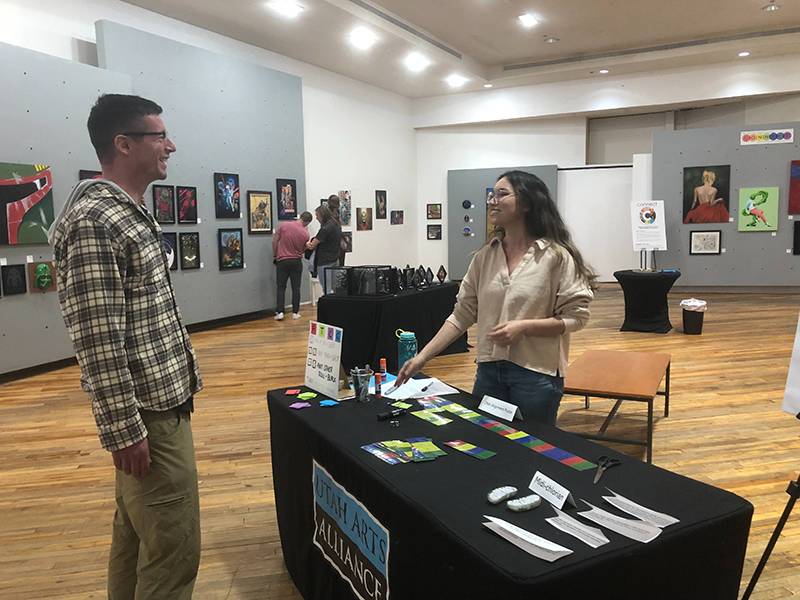
Letter From STEMAP Team
Dear STEM Ambassadors and Community Partners,
STEMAP has had a busy and exciting spring! Our Spring 2022 STEMAP cohort at the University of Utah (UU) wrapped up with a wonderful Reflection Meeting in May. Our Ambassadors engaged with several new community groups in the Salt Lake Valley both virtually and in person. You can read about the experiences of members of this Spring cohort and one member of the Summer 2021 Research Ethics cohort in the Reflect Section.
The STEMAP team offered two Broader Impacts Workshops with the Research Education office this spring and has plans to lead additional workshops this summer including a workshop specifically tailored to students applying for the NSF Graduate Research Fellowship Program (GRFP) on June 29. You can register for this GRFP Broader Impacts workshop here. We have also consulted with several researchers at the UU and a number of external institutions on designing innovative Broader Impacts and developing future STEMAP collaborations for NSF, DOE, and NASA proposals.
Finally, STEMAP is going through several leadership changes this summer! With Dr. Nalini Nadkarni’s retirement becoming more official each month (despite continued NSF funding and ongoing field research projects!), she has made the decision to pass on the STEMAP Director role. We are thrilled to welcome Dr. Sara Yeo, Associate Professor of Communications, as our new STEMAP Faculty Director. Nalini will remain involved in STEMAP leadership as our Senior Advisor. Andrew George has started a new role as the Associate Director of STEMAP, and we are in the process of hiring a new Program Coordinator as Megan Young starts the next chapter of her career in Idaho. We extend a huge thank you to Meg for the substantial impact she has had on STEMAP over her many years on the team! You can read more about our leadership transitions in the Director Transition section below.
We are grateful for your continued support of public engagement with science and STEMAP's work!
Nalini M. Nadkarni
Founder and Senior Advisor, STEM Ambassador Program
Sara K. Yeo
Director, STEM Ambassador Program
Andrew B. George
Associate Director, STEM Ambassador Program
STEMAP Spring Cohort Comes to a Close
The Spring 2022 cohort at the University of Utah concluded with a fun and inspiring Reflection Meeting in May. Ambassadors engaged with several exciting community focal groups including SheTech, the Utah Arts Alliance, the 4H Club of Tooele County, Comunidades Unidas, the SLC and Ogden Farmer’s Markets, and many others! STEMAP staff are in the process of compiling an extensive database of our Ambassadors’ community partners to aid future Ambassadors and scientists in connecting with groups interested in additional public engagement programming.
You can read more about the STEMAP experiences of a couple of members of this cohort in the Reflect Section below.
STEMAP Director Transition
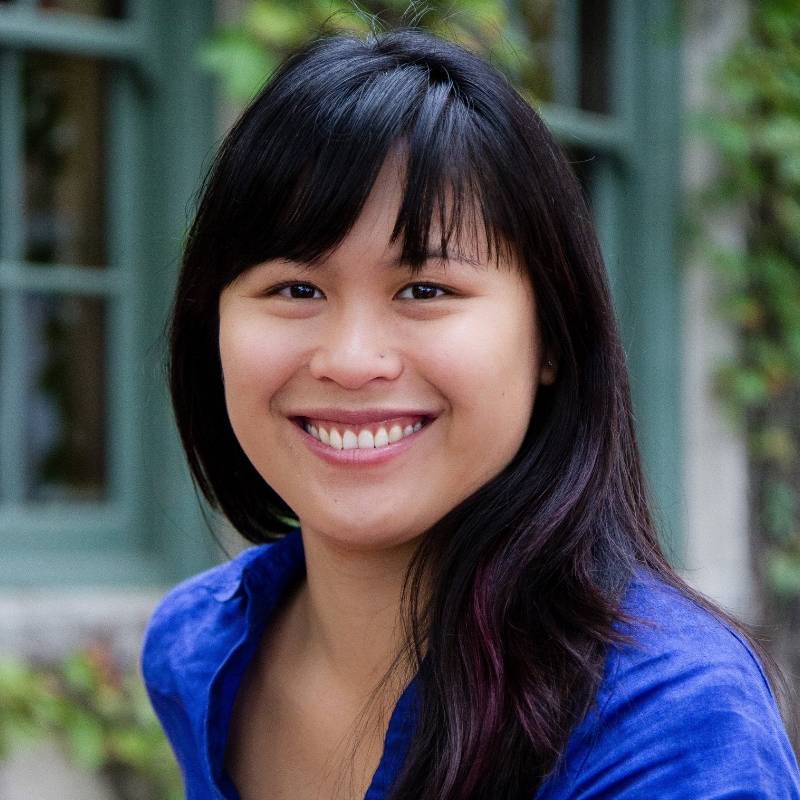
After founding the STEM Ambassador Program and serving as its Director and NSF Principal Investigator for six years, Nalini Nadkarni is ready to hand leadership of the program over to our new Director, Sara Yeo, and Associate Director, Andrew George. Since STEMAP’s founding in 2016, Nalini and her team have trained over 170 scientists associated with nearly 20 institutions in public engagement with science skills. Together these Ambassadors have designed and implemented innovative public engagement events for more than 70 unique community groups. And fear not, Nalini will remain closely connected to the program as our new Senior Advisor, a role in which she will help our team expand and sustain STEMAP’s training offerings. Nalini also continues to secure competitive NSF funding to support her many forest ecology field research projects in Costa Rica. We thank Nalini for all her hard work and dedication to public engagement with science and the STEM Ambassador Program and are so pleased that she will remain involved as our Senior Advisor!
We are thrilled to announce that Dr. Sara Yeo, Associate Professor of Communications at the University of Utah, will be taking over as our new STEMAP Director this summer. Sara’s research focuses on the role of humor in science communication, and she is well connected with national science communication and public engagement with science professional networks. Sara has been working with the STEMAP team for a few months now and already has some excellent ideas for expanding and sustaining the training and research arms of STEMAP. We are excited to officially welcome Sara to our team, and we hope you have the opportunity to meet and work with her soon!
STEM Community Alliance Program Opportunities and Activities
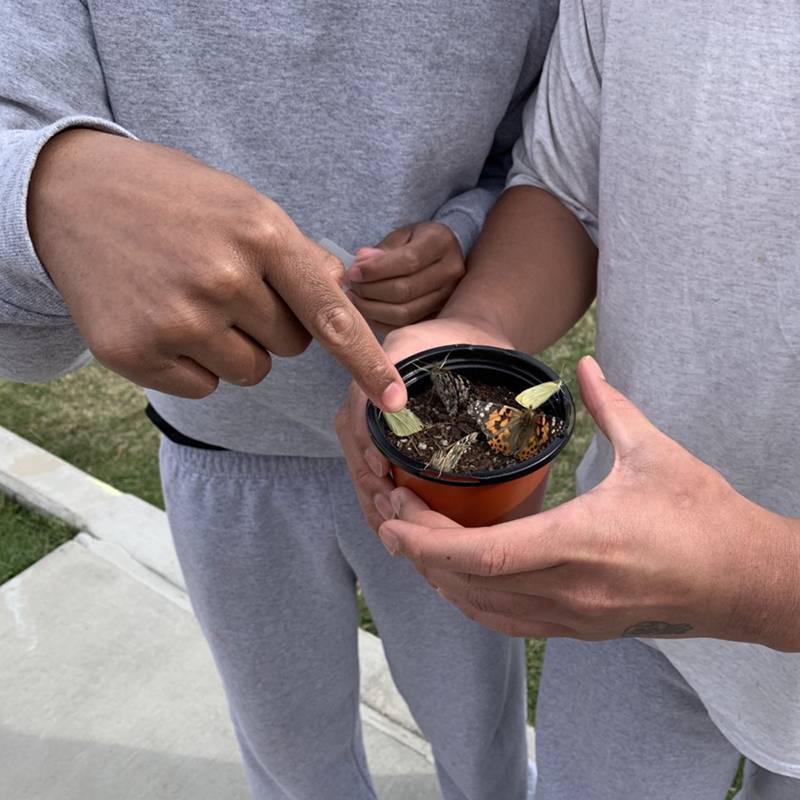
Students at an introductory planting lesson. They released butterflies in celebration of the start of the Milkweed Project for Monarch conservation.
The STEM Community Alliance Program (STEMCAP) provides science activities, workshops, and conservation projects in several Youth-In-Custody facilities around the Salt Lake area. Many of our Ambassadors have worked with STEMCAP, and past workshops have included topics such as wildlife management, botany, materials sciences, art and science, psychology, and more. E-mail Laura George, the STEMCAP Associate Director, if you would like more information. STEMCAP is recruiting interested scientists to participate in their programming, and you can apply to present with STEMCAP through the program website.
STEMCAP has recently published a beautiful Zine highlighting the excellent student artwork that has resulted from STEMCAP workshops! You can access a digital version of the Zine here.
Broader Impacts Workshops and Consultations
The STEMAP team continues to work with the Office of Research Education (REd) at the University of Utah to provide Broader Impacts information and interactive brainstorming activities for grant writing workshop participants. You can register for a Broader Impacts Workshop specifically tailored for students applying to the NSF Graduate Research Fellowship Program (GRFP) on June 29th here.
We are also continuing to offer one-on-one Broader Impacts Consultations for faculty and students applying for NSF funding. During these consultations, Andrew and Sara guide researchers in developing ideas for innovative public engagement activities aligned with the researchers’ research and personal interests. You can sign up for a Broader Impacts Consultation through the REd website.
STEM Ambassador Reflections
Below you will find reflection articles written by STEM Ambassador Program alumni. These activities were carried out according to institutional guidelines on in-person interactions at the time of the events. Please follow the health guidance of your local institutions when scheduling public engagement events.
Cecile Avery at the Urban Arts Gallery
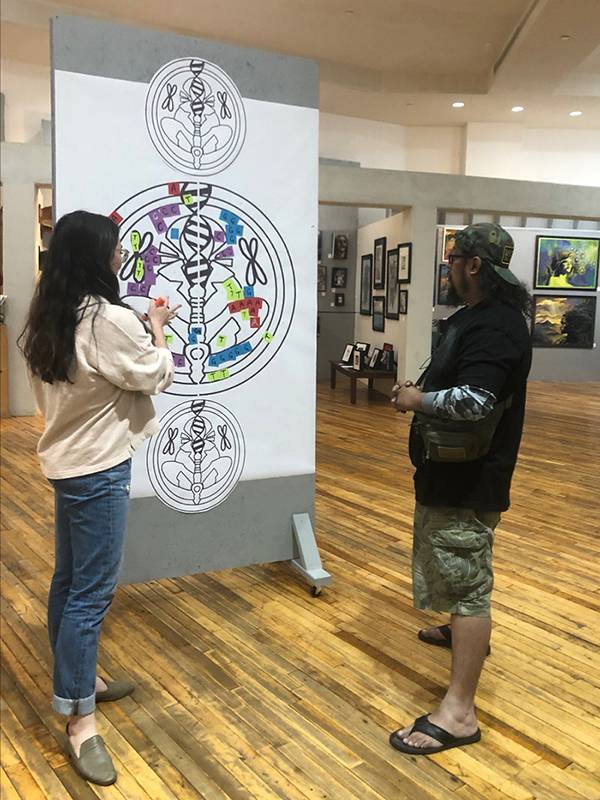
The “paint by number” is a twist on the mosaic on the floor of the first Jedi temple.
There always seemed to be something binary about growing up and choosing if you preferred the arts or the sciences. At first glance, I get where it comes from. The arts can be impulsive, expressionistic, and freeing. Math and science tended to follow rules, centered on solving hard problems, and logic. At one point in my life, I thought I would finish my degree in biology and pursue art school because I just couldn’t “pick a side.” After realizing I wasn’t cut out for making a career out of my art, I arrived at the University of Utah to earn a PhD in Human Genetics.
This transition didn’t mean that I quit creating altogether, however. When I was tasked to think about the full spectrum of my interests and hobbies outside of science, it occurred to me that I could bring my science to a room full of artists. There’s a certain thrill in merging these two concepts- art and science. I’m certainly not the first to do it, but I was happy for the excuse. After some deliberation, I decided to coordinate with the Utah Arts Alliance (UAA) and set up a table in the Urban Arts Gallery. The UAA has several different programs and projects, but the Urban Arts Gallery is part of a large, monthly, city-wide gallery stroll that feels similar to an open house. I gathered some information about the theme for that month, given that some of the artists are part of a rotating selection, and got to work designing a piece that would fit in.
I was set to participate in May and it is an Urban Arts Gallery tradition to have a Star Wars theme (May the 4thaka “May the Force be with you”). A key component of my research is searching for rare genetic variants that can increase one’s risk of developing autoimmune arthritis- particularly in children. This type of work relies heavily on huge datasets representing known, natural human variation. I decided that I would represent this by setting up a community “paint by number” with only four colors of paper. Each color represented a base (A, T, C, G). In addition, there would be three different colors of markers: black, silver, and gold. I set up three categories for each color marker which would be chosen by rolling two dice. Writing out “A” on a red piece of paper with a black marker for instance, was a common outcome. But if you rolled a pair of sixes, you would write the “A” in gold (the rarest outcome). The more people participated, the more the Star Wars themed image I designed would come into focus. For this project, I choose a genetics twist on the mosaic on the floor of the first Jedi temple. I also drew a pedigree depiction of “Force sensitivity” in Luke and Leia’s family tree and a 3D printed mitochondria that I pretended was a midi-chlorian. For the uninitiated, force sensitivity is ascribed to one’s midi-chlorian count.
The day of the gallery stroll, I had several opportunities to talk about my research, but also sci-fi as a creative depiction of scientific ideas. I’m not well versed in Star Wars lore, but I enjoyed the enthusiasm of fans filling me in on the details and how they fit into the concepts I presented. It was also a lot of fun to show participants how it’s possible to blend genetics concepts and art. I may have been ambitious with the size of the ‘paint by number’ and didn’t realize that most of my time would be spent having conversations versus doing the planned activity. A good problem to have but something I’ll keep in mind in the future.
I want to thank Jonathan King, the event coordinator at UAA for supplying materials and equipment and for the opportunity to engage with their community. I’d also like to thank the entire STEMAP team for their mentorship and support – I’ve learned valuable lessons by being encouraged to go out and try things on my own and being empowered to continue my engagement efforts outside of my involvement with STEMAP.

A table with materials, 3D models, and self-guided Q&A was a great way to pull participants in. The table was set up towards the back half of the gallery space, next to other Star Wars themed pieces. The “paint by number” activity is a few feet behind the table (not pictured).
Lisa Rigtrup at The Salt Lake FanX Comic Convention
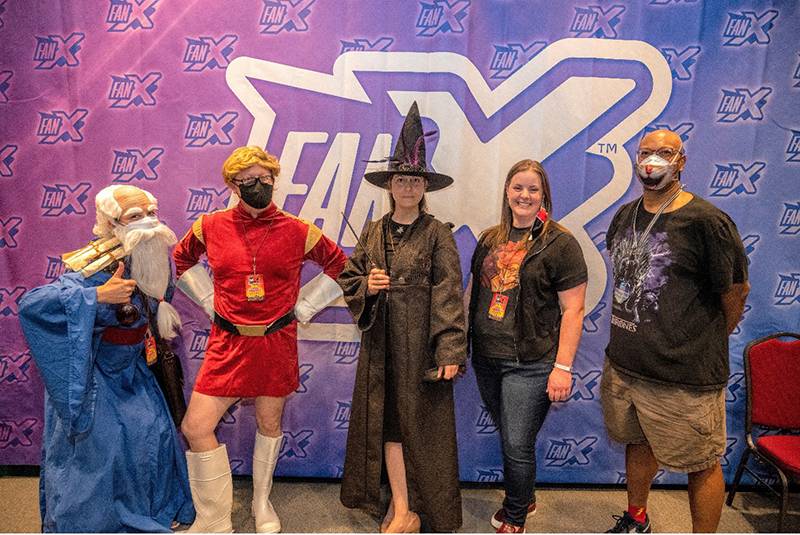
Panelists from The Salt Lake FanX Comic Convention panel titled “MAD SCIENCE ON TRIAL: THE REAL ETHICAL PROBLEMS WITH FICTIONAL SCIENTISTS”, September 2021. Pictured left to right: Dr. Ashley Guajardo, Adam Hunter, Dr. Ann Johnson, Lisa Rigtrup, Dr. Paul White.
What would happen if a panel of real research ethics experts examined some of the most famous (and infamous) scientists from movies, games, and comics? This was the question on my mind as I brainstormed panel submission ideas for Salt Lake City’s FanX Comic Convention. I hoped to find a way to engage the convention attendees in a fun discussion about fictional science experiments while also teaching them about real-world research ethics.
FanX is an annual event that attracts thousands of people from the local community who are interested in science fiction, comic books, games, pop culture – and everything in between. As a veteran attendee of the Con since its very first year in Utah, I knew it would be an exciting venue to connect with a distinctive community already interested in science.
I recruited several of my colleagues from the University of Utah Institutional Review Board (IRB) to serve as panelists at the event. The IRB is a committee responsible for reviewing research studies that include people to make sure they are safe and ethical. My panelists – who were also members of the IRB board – had expertise in a variety of applicable disciplines including entertainment arts, computer engineering, game design, social psychology, and public health. We decided our panel would focus on three examples of research from some of our favorite movies and games.
“There’s that experiment Peter Venkman does in ‘Ghostbusters’ where he electrocutes the male participant and flirts with the cute girl,” one panelist said.
“We’ve got to do something from ‘Back to the Future’,” another suggested. “Doc Brown is an ethical disaster and very entertaining to talk about.”
“What about Catherine Halsey from the ‘HALO’ video games? She abducted children and transformed them into super soldiers… that could be interesting to talk about,” I said.
We collected these ideas and submitted our panel proposal, titled, “MAD SCIENCE ON TRIAL: THE REAL ETHICAL PROBLEMS WITH FICTIONAL SCIENTISTS” to the FanX Selections Committee. The convention organizers enthusiastically accepted our submission.
The Salt Palace was abuzz when we arrived. As nervous as we were about con-goers being interested in the ethics of research, there was a sizeable crowd in attendance. We called our review panel to order, and each of the panelists presented their case and made arguments for or against the ethics of the research. After each presentation, we opened the discussion up to the audience for comments and feedback. The audience dove right into the discussion right up until we had to end the panel for time, and several attendees came up to us afterwards to chat a bit more about the discussion and to find out who we were and how they could learn more. We handed out business cards with a QR code that led to the IRB’s community website, https://myirb.utah.edu/.
I am grateful to my fellow panel members and the Salt Lake FanX Comic Convention for supporting this venture. I hope to be able to continue organizing and hosting similar events in the community that will allow the IRB to connect with the public and answer questions about human subject research protections.
Anna Bell at SheTech Explorer Day

Left: Example data portrait and questions. Right: Participants engaging with the Anna’s and Derya’s data science booth.
As a non-traditional student who took their first programming course at the age of 24, I am passionate about encouraging others to imagine themselves in STEM fields. I believe data science can be engaging for students with a wide variety of interests, in both the arts and sciences. As a woman in STEM that is passionate about diversity and equity, I was especially interested in introducing young women to data science. So, for my first STEMAP event, I chose to do a workshop with young women in high school through a local program called SheTech. Here’s the SheTech website, where you can learn more about the program.
My project involved several moving parts and volunteers, including a number of STEMAP Ambassadors who volunteered to participate in the project. I taught three workshops at the SheTech Explorer Day event in March 2022 at the Mountain America Expo Center. Through the Women Tech Council, which is a national organization that organizes the SheTech program, I was able to design a workshop called “What is Data Science?” and reserve a booth dedicated to data science in collaboration with the Data Science Club and the Utah Center for Inclusive Computing (UCIC).
In my “What is Data Science” workshop, students had the opportunity to interact with a survey and visualization generator through Observable. This survey and visualization tool was designed by myself and Derya Akbaba. Derya is another STEM Ambassador, and her contributions were central to the workshop’s engagement activity. Derya’s data portraits were a novel way to represent individuals. The survey we used to generate data for these portraits also helped facilitate interesting ethical discussions about data science, such as:
- What questions should be asked, and when?
- How do we know that our survey will represent the population we are trying to understand?
- In what situations are the survey results appropriate or inappropriate to use?
- What are the limitations of our particular approach, and how might our approach be improved?
Here are my reflections on the event, organized using the STEMAP training program principles:
Connect: Youth who intersect more than one underrepresented population in STEM attended this event, which made engaging with high school girls even more meaningful.
Immerse: I was surprised to see that NOBODY in all three of my workshops had heard about data science before!
Design: Derya Akbaba did an amazing job designing data portraits. We chose the questions together and then she came out with the portrait generator AND an interactive site for the students to see what the code was like “under the hood.” The students were enthusiastic about engaging with this activity and the discussion that followed.
Engage: We prepared a lot…and a lot of things didn’t go the way we thought they would. The WIFI was too slow (because of all the other workshops, etc) for us to transfer the survey results to a booth where volunteers from the Data Science Club were ready to engage with students and make buttons with the data portraits.
Reflect: The students at the event had a lot to say about the limited selection of hobbies we provided in our questions. This was the feedback we asked for! We wanted to talk about the ethical implications of asking survey questions, etc.
I would like to thank the volunteers who helped make this event possible. Specifically, I would like to thank Kristin Wright from the Women Tech Council, who made both the booth and workshops possible. For assistance with organizing the Data Science booth, I’d like to thank Emily Howsley and Megan Bettilyon, as well as the Data Science club volunteers: Serena Aeschilman, Bryce Shoemaker, and Adriana Salazar. It was also an honor to have multiple STEM Ambassadors participate in this event. Thank you, Brooke Gates and Callie Clontz for volunteering to help with the data science booth, and a special thank you to Derya Akbaba for the data portrait design and implementation. Finally, I’d like to thank STEMAP leaders Megan Young and Andrew George for their mentorship as I pursued this ambitious community engagement project.
About the Blog
Discussion channel for insightful chat about our events, news, and activities.
Categories
Featured Posts
Tag Cloud
- UoG (2)
- Guam (2)
- ethnobotany (1)
- environmental policy (1)
- student immersion (1)
- engineering (1)
- Virgin Islands (1)
- USVI (2)
- lionfish (1)
- children's home (1)
- conservation (1)
- marine ecology (1)
- youth (1)
- sustainability (2)
- Utah (1)
- Arizona (1)
- Nevada (1)
- southwest (1)
- virtual (1)
- project management (1)
- training (1)
- naturalist (1)
- forest (1)
- ecosystem (1)
- Puerto Rico (1)
- Spanish (1)
- library (1)
- Huntington's (1)
- medical science (1)
- Emmanuel Ngwoke (1)
